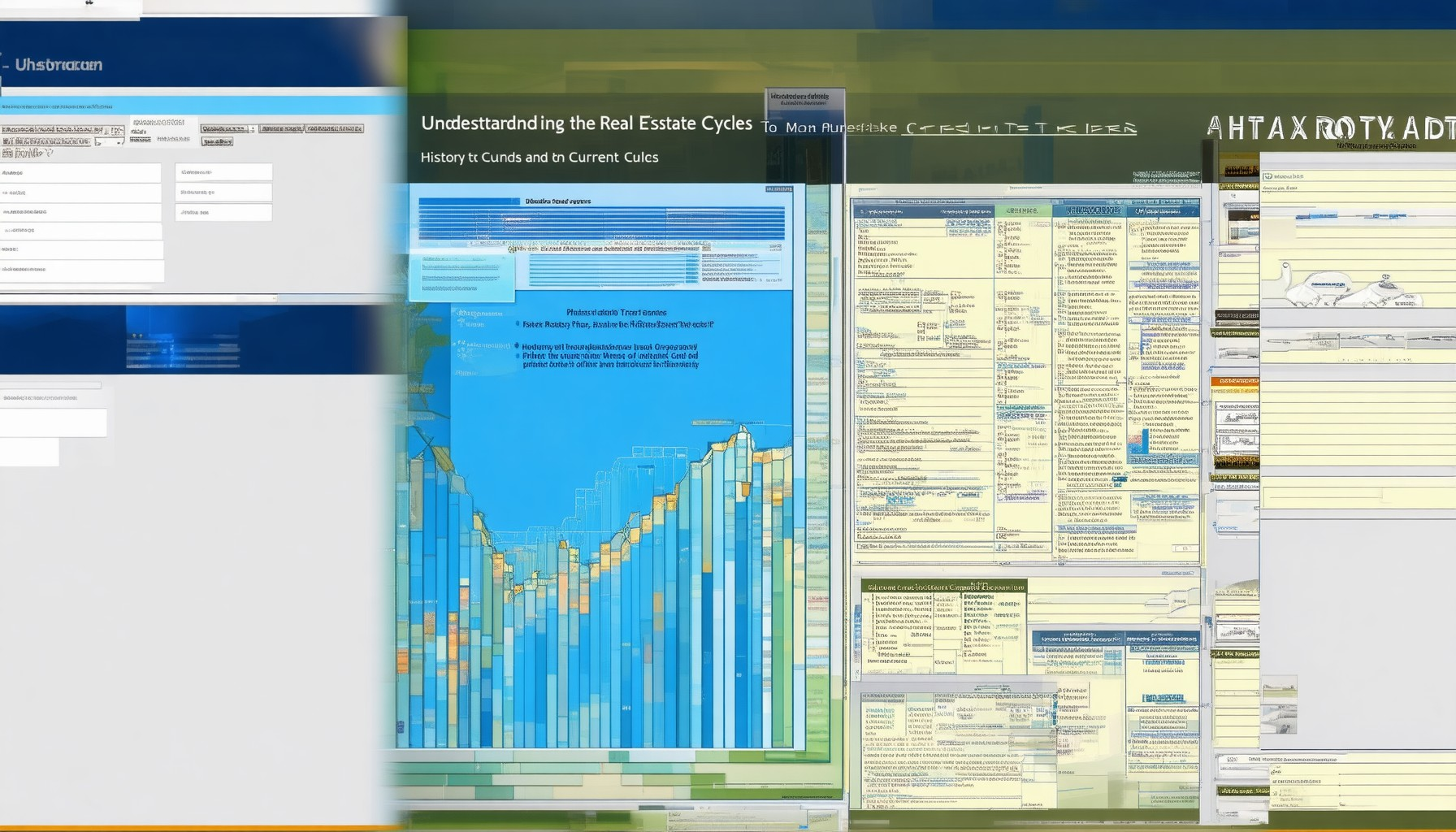The real estate market operates on a dynamic cycle that significantly impacts both buyers and sellers. Understanding the patterns, phases, and historical context of real estate market cycles is crucial for making informed investment decisions, navigating the housing market, and staying ahead of trends. In this comprehensive guide, we will explore the intricate details of the real estate cycle, its historical progression, and the current trends shaping the market. By examining the key phases, tools, and expert predictions, this article aims to provide a clear roadmap for anyone looking to thrive in today’s ever-evolving housing market. Whether you’re a seasoned investor or a curious learner, this guide will offer valuable insights into the cyclical nature of real estate and how it influences your financial goals.
Key Takeaways
- The real estate market operates in cyclic patterns, comprising distinct phases that influence buyer behavior and market trends.
- The current real estate cycle is in the early stages of the Expansion Phase, driven by low interest rates and demographic trends, though housing inventory remains a challenge.
- Understanding these phases is crucial for making informed decisions, whether you’re buying, selling, or investing.
- Local market conditions can vary, so staying updated is essential for tailoring strategies to regional trends.
- For detailed insights and expert advice, explore the Real Estate Locations platform to gain comprehensive understanding and guidance.

Understanding the Real Estate Cycle
The real estate market operates in a cyclical pattern, characterized by distinct phases that influence buyer behavior, investment strategies, and market trends. Understanding these phases helps stakeholders make informed decisions. Below are the four primary phases of the real estate cycle:
- Recovery Phase
- During this phase, the real estate market begins to stabilize after a period of decline. Key indicators include bottoming-out prices, stabilizing interest rates, and increased buyer activity.
- Factors driving recovery include economic stabilization, job growth, and pent-up demand from buyers who delayed purchases during downturns.
- Investors often capitalize on opportunities during this phase by acquiring undervalued properties at lower prices.
- Expansion Phase
- As the economy strengthens, demand for housing outpaces supply, leading to price appreciation and heightened competition among buyers.
- Urbanization, demographic trends (e.g., millennials entering the housing market), and infrastructure development fuel this phase.
- Developers actively construct new projects to meet growing demand, often resulting in rising property values and profit potential for sellers.
- Hypersupply Phase
- This phase occurs when the supply of available properties exceeds demand, often due to excessive construction and changing buyer preferences.
- Key characteristics include rising vacancy rates, slower price growth, and challenges for developers facing high inventory levels.
- Buyers may encounter more negotiation power during this phase, while sellers face reduced demand and pricing pressures.
- Recession Phase
- Economic downturns, such as those caused by financial crises or global recessions, lead to a sharp decline in real estate activity.
- Prices fall significantly, foreclosure rates rise, and investor confidence plummets.
- This phase typically lasts until the economy shows signs of recovery, setting the stage for the next cycle to begin.
Understanding these phases allows investors, buyers, and sellers to align their strategies with market conditions, maximizing their outcomes in the ever-changing real estate landscape.
The 4-3-2-1 Rule in Real Estate
The 4-3-2-1 rule is a commonly used method in real estate appraisal and pricing to determine the market value of a property based on its size and features compared to other similar properties in the area. Here’s a breakdown of how it works:
- 4: This represents the highest comparable property in terms of size, features, and condition. It serves as the benchmark for valuation.
- 3: The second-highest comparable property, which may be slightly smaller or less upgraded than the first but still closely matches the subject property in key attributes.
- 2: The third-highest comparable property, which may differ more significantly in size, features, or condition compared to the others.
- 1: The lowest comparable property, typically the smallest, simplest, or least upgraded property in the comparison set.
This method allows appraisers and evaluators to establish a range of values for the property by comparing it to these four benchmarks. The goal is to ensure that the valuation is reasonable and reflects the current market conditions accurately.

What Are the 4 Market Cycles?
The stock market and overall financial markets operate in cycles, which are patterns of growth and decline that repeat over time. These cycles are essential to understand for investors and traders. Below, we outline the four primary market cycles:
1. Accumulation Phase
- During this phase, prices tend to rise due to increased demand and strong economic conditions.
- Companies benefit from rising revenues and profits.
- This phase often lasts until supply catches up with demand.
2. Mark-Up Phase
- Prices continue to increase as demand exceeds supply.
- Companies may face challenges meeting production demands.
- This phase is characterized by high profitability for businesses.
3. Distribution Phase
- Prices begin to stabilize or decline as supply starts to meet demand.
- Companies may struggle to maintain high profit margins.
- This phase marks the end of the bull market cycle.
4. Downturn Phase
- Prices drop significantly as investor confidence wanes.
- Economic uncertainty leads to reduced consumer spending.
- This phase typically signals a bear market.
Impact on Real Estate
The real estate market closely mirrors broader economic trends. During the accumulation and mark-up phases, real estate values often rise as investors seek safer assets. However, during the downturn phase, real estate prices may decline, affecting homebuyers and investors alike.
Key Takeaways
Understanding market cycles helps investors anticipate market movements and make informed decisions. By recognizing the signs of each phase, you can better navigate the ups and downs of the financial markets.
Explore different real estate locations to find opportunities that align with your investment goals.

What is the Current Real Estate Cycle?
The real estate market operates in cycles, which are influenced by various economic factors. Understanding the current real estate cycle helps buyers, sellers, and investors make informed decisions.
Key Phases of the Real Estate Cycle
- Recovery Phase: This phase begins after a market downturn. Prices stabilize, and demand starts to rise as confidence returns.
- Expansion Phase: Demand outweighs supply, leading to rising prices and increased activity. This phase often lasts for several years.
- Peak Phase: Property values reach their highest point due to high demand and limited supply. This phase may see rapid price increases.
- Contraction Phase: Market demand decreases, causing prices to drop. This phase can last for a few years until the market stabilizes again.
- Trough Phase: The lowest point of the cycle, marked by low prices and high inventory. This phase sets the stage for the next recovery.
Current Market Trends
As of recent analysis, the real estate market appears to be in the early stages of the expansion phase. Factors such as low interest rates, demographic trends, and job growth are driving demand. However, housing inventory remains a challenge in many regions.
It’s important to stay updated on local market conditions, as trends can vary by region. For detailed insights and expert advice, visit our Real Estate Locations platform.
What Are the Key Phases of the Real Estate Market Cycle?
The real estate market operates in a cyclical pattern, characterized by distinct phases that influence buyer behavior, investment strategies, and market trends. Understanding these phases helps buyers, investors, and enthusiasts make informed decisions. Below are the six primary phases of the real estate market cycle:
- Recovery Phase
- During this phase, the housing market begins to stabilize after a period of decline. Interest rates may rise, attracting first-time buyers and refinancers. Prices often bottom out, and demand starts to increase due to low inventory levels. Investors may begin to reenter the market, seeking opportunities in undervalued properties.
- Learn more about the recovery phase.
- Expansion Phase
- As confidence grows among buyers and sellers, prices begin to rise steadily. Construction activity picks up, leading to increased competition among real estate professionals. This phase is typically marked by strong economic fundamentals and rising demand for housing.
- Explore the expansion phase in detail.
- Peak Phase
- The peak phase occurs when housing prices reach their highest point due to high demand and limited supply. This phase often coincides with rising interest rates, which can deter potential buyers. Sellers may hold out for even higher prices, creating a challenging environment for first-time buyers.
- Discover more about the peak phase.
- Decline Phase
- The decline phase signals a slowdown in the market as interest rates rise and economic uncertainty increases. Sales volume drops, and prices begin to fall. This phase can last for several years, creating opportunities for buyers and investors looking for discounts.
- Dive into the decline phase.
- Bottom Phase
- The bottom phase represents the lowest point in the market cycle, often marked by stabilized prices and reduced activity. This phase can be an ideal time for buyers to secure affordable properties and for investors to find bargains.
- Understand the bottom phase.
- Rebound Phase
- The rebound phase signifies the beginning of a new cycle as interest rates decrease, spurring buyer activity and renewed growth in the housing market. Prices start to rise again, and construction picks up, setting the stage for the next cycle.
- Learn about the rebound phase.
By understanding these phases, buyers and investors can strategically time their purchases and sales to align with market trends, maximizing their returns and minimizing risks.

What Are the Key Phases of the Real Estate Market Cycle?
The real estate market operates in a cyclical pattern, characterized by distinct phases that influence buyer behavior, investment strategies, and market trends. Understanding these phases is crucial for anyone looking to navigate the real estate landscape effectively. Below, we outline the six primary phases of the real estate market cycle:
- Recovery Phase
- This phase typically follows a market downturn, marked by rising interest rates and increased demand for affordable housing. Prices begin to stabilize, and inventory starts to recover after years of decline. Investors often capitalize on distressed properties during this phase.
- Expansion Phase
- As the economy strengthens and consumer confidence grows, demand for housing accelerates. Construction activity picks up, leading to increased competition among buyers. Prices rise due to limited supply, creating a seller’s market.
- Peak Phase
- The peak occurs when housing prices reach their highest point, driven by low interest rates and high demand. Construction slows down as building costs rise, and buyers become more cautious. This phase often signals the beginning of a potential downturn.
- Decline Phase
- Rising interest rates, economic uncertainty, and an oversupply of homes lead to a slowdown in price growth. Sellers reduce their asking prices, and buyers become more hesitant. This phase can last for several years before the market stabilizes.
- Bottom Phase
- Prices hit rock-bottom levels, attracting investors and cash buyers. Distressed properties dominate the market, and construction activity reaches its lowest point. This phase presents opportunities for long-term investors willing to wait for recovery.
- Rebound Phase
- The final phase is marked by steady price appreciation and renewed buyer interest. Inventory remains tight, and construction begins to pick up again. The cycle then repeats, influenced by broader economic factors.
Understanding these phases helps buyers, sellers, and investors make informed decisions tailored to market conditions. To delve deeper into each phase and explore strategies for thriving in the real estate market, visit Real Estate Locations .
By staying informed about the real estate market cycle, you can better position yourself to take advantage of opportunities and mitigate risks, ensuring your decisions are aligned with current market dynamics.




0 Comments